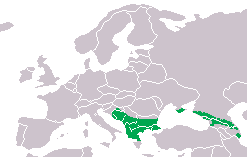Southern crested newt facts for kids
Quick facts for kids Southern crested newt |
|
|---|---|
 |
|
| Conservation status | |
| Scientific classification | |
| Genus: |
Triturus
|
| Species: |
karelinii
|
 |
|
| Synonyms | |
|
|
The southern crested newt (Triturus karelinii) is a type of newt that lives on land in Europe. It looks a lot like the northern crested newt (Triturus cristatus). However, the southern crested newt is usually bigger and stronger.
Scientists have learned more about these newts over time. In 2013, a group of newts that used to be called southern crested newts were given their own name: the Balkan-Anatolian crested newt. Then, in 2016, another group was separated and named the Anatolian crested newt. This means the southern crested newt's known home range changed a bit!
Contents
What Does a Southern Crested Newt Look Like?
Southern crested newts have a unique appearance. Their backs are usually brown or gray, with darker spots scattered all over. Their bellies and throats are bright orange, covered with tiny black dots.
Size and Special Features
These newts can grow to be quite large, up to 7.1 inches (18 centimeters) long. Male newts have a special feature during breeding season. They grow a big, jagged crest that runs from behind their necks all the way down to their tails. This crest helps them attract mates.
Where Do Southern Crested Newts Live?
Southern crested newts are found in specific parts of the world. You can find them in Crimea, which is a peninsula. They also live in the Caucasus region and areas south of the Caspian Sea.
Understanding Their Home Range
It's important to remember that some newts that look similar are now considered different species. For example, newts found in the southeast Balkan peninsula and western Anatolia are now known as the Balkan crested newt. Those in northern Anatolia are called the Anatolian crested newt. This helps scientists understand where each type of newt truly lives.
What Kind of Places Do They Call Home?
The southern crested newt is very adaptable. It can live in many different kinds of mountain environments.
Favorite Habitats
These newts enjoy both forests with wide-leaf trees and coniferous forests (forests with trees like pines and firs). They also live on mountain slopes and flat areas called plateaus. They need places with good cover and access to water.
Life Cycle of the Southern Crested Newt
Southern crested newts grow and change throughout their lives. They become old enough to have their own babies when they are about three to four years old.
Breeding and Lifespan
During the time of year when they reproduce, these newts spend a lot of time in water. You can find them in many different water sources, such as swamps, lakes, still ponds, ditches, and even temporary pools of water. They also use streams. Male newts typically live for about eight years, while females can live a bit longer, up to 11 years old.


